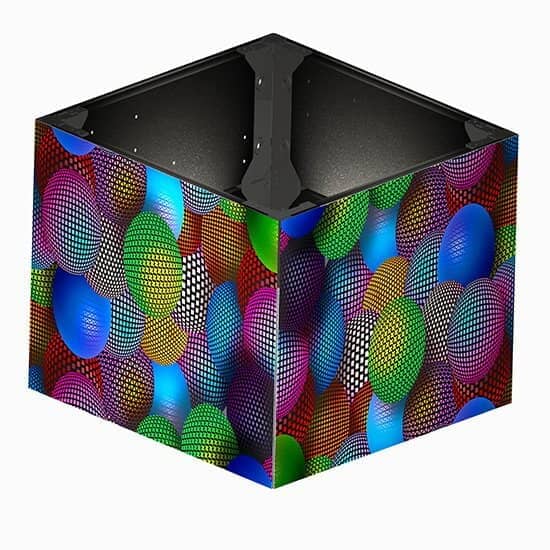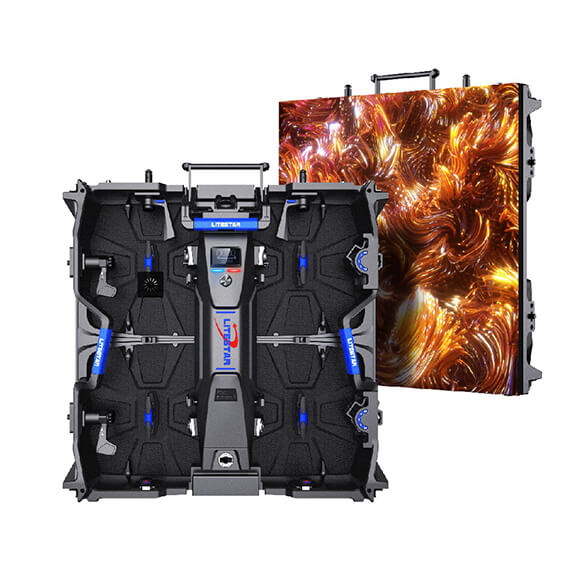Currently, there are over 80,000 screens in
cinemas in China, ranking first in the world. Projection has been the main
equipment for the screens of movies since the movie was invented in 1895.
However, LED screens, a new technology, will provide cinemas with a better
option.

LED screens have a few advantages over
laser projection, the latest technology in the projector industry. Laser
projection is greatly affected by ambient environment. Because the angle
between the laser projection projector and the screen is small, the ability to
resist the influence of ambient light is poor, so it can only be applied in low-brightness
scenes. Based on the self-luminous characteristics of LED display screens, LED screens
can be used for both low-brightness and high-brightness scenes. In terms of
resolution, laser projection is affected by the projection chip. At present,
only the resolution can reach 4K, while the LED display can be higher. The
resolution of the LED display can reach 8K or even higher in the near future
due to the development of the technology
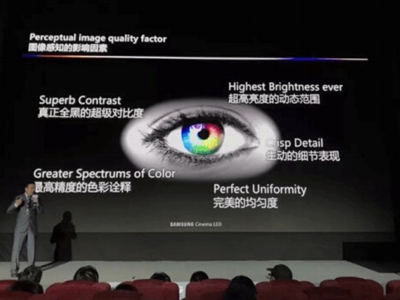
LED displays have to comply with DCI
standards if they are used for movie theaters. The DCI organization was jointly
created by the world's six largest film companies to establish a unified
digital movie playback standard, and to protect the copyright of digital movies
and ensure the audio-visual experience of theaters. The DCI standard covers
data formats, codec interfaces, transmission methods, security, and theater
hardware systems including servers, projection, audio, and control.
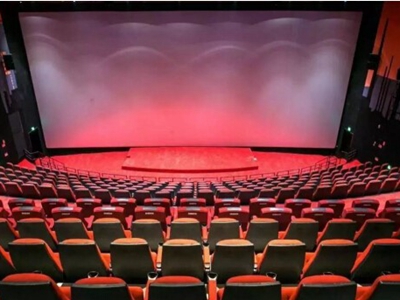
DCI's requirements for display images
include screen resolution, brightness, color of image, etc
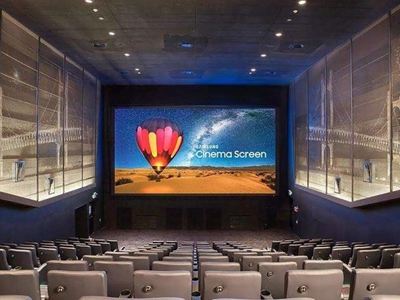
The resolution of the screen is 2K (2048 x
1080) or 4K (4096 x 2160), the brightness is 48 ± 10.2 nits, and the contrast
ratio is at least 1200:1 (the test condition is theater ambient light, and the
reflection of the screen is less than 0.03 nits ), the white balance point has
the color gamut requirements as shown in Figure 1, while allowing a certain
error. The main saturation wavelengths corresponding to the standard R, G, and
B primary colors are 100% 621nm, 89.5% 544nm, and 92.9% 465nm, respectively.
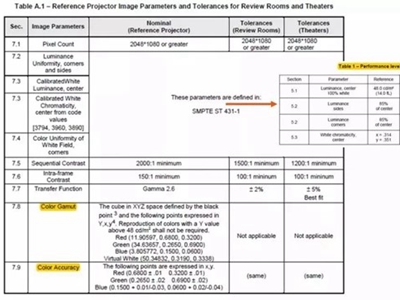
Requirements of brightness
According to the brightness requirement of
48 Nits, the pixel pitch of 2.5mm, and the driving mode of 30 scans, the
luminous brightness of each LED is 9mcd. Calculated according to the
requirements of the DCI white balance point, the ratio of the three primary
colors is R: G: B = 20.9: 72.2: 6.9, for a single LED R, G, B brightness
requirements are 1.9mcd, 6.5mcd, 0.6mcd. Such a brightness specification is
much smaller than the current mainstream SMD1010 luminous brightness.
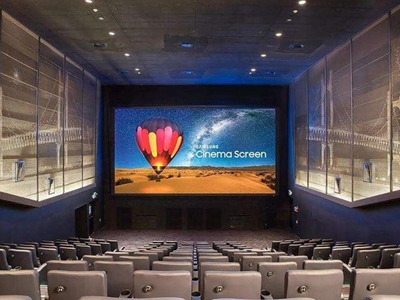
It is true that the LED display control
system can reduce the LED display with high design brightness to 48 nits
through gray scale control, but it will bring many low gray display problems,
such as red color floating, pixel unevenness and so on.
Limited by the minimum current specification
of the drive chip, the drive current of the LED cannot be reduced indefinitely.
This requires the LED to reduce the luminous brightness through its own design,
such as further reducing the chip size or entering more into the package.
Light-absorbing particles. However, this is all at the expense of photoelectric
efficiency. If the minimum drive current of the drive chip can be further
reduced, or the number of supported scans can be further increased, the
brightness of the LED display can be reduced without sacrificing the
photoelectric efficiency. For the LED itself, only the R, G, and B chip ratios
that are suitable for the color ratio of the DCI white balance point are
accurately selected, and the brightness that can meet the current requirements
of the driving chip in the future, is the most perfect LED that meets the
application requirements.
LED color requirements
According to the DCI-P3 color gamut defined
by DCI, the R, G, and B primary colors of the display have strict color
coordinate requirements. For LED displays, strict color coordinate
specifications are required for LEDs. However, currently on the market, most
LED suppliers use dominant wavelength specifications to define colors, and
dominant wavelengths are colors defined from one dimension (hue), missing
another dimension (saturation) of color information. The color of the same
dominant wavelength corresponds to a straight line passing through the
iso-energy point (0.333, 0.333) in the color space, rather than a precise color
point. Therefore, in order to accurately meet the requirements of the DCI-P3
color gamut, it is first necessary to select an LED whose color coordinates
define the color, rather than an inaccurate definition of the dominant
wavelength.
Due to the principle of display light
mixing, the initial design color gamut of the display screen can be equal to or
greater than the DCI-P3 color gamut, that is, the initial design color
coordinates of the three primary colors of R, G, and B need not be directly the
color coordinates specified by DCI-P3. It is the area formed by the bilateral
extension line of each base point and the color space boundary as shown in the
figure (as shown in Figure 2). Among them, green and blue are respectively a
small area similar to a triangle. Due to the color dispersion of LEDs, such a
small color range is almost impossible to achieve in mass production of LEDs;
for red, the basis point specified by DCI-P3 has been Located on the boundary
of the color space (saturation 100%), so in theory, LED has no possibility of
satisfaction.
 English
English  Esperanto
Esperanto  Afrikaans
Afrikaans  Català
Català  שפה עברית
שפה עברית  Cymraeg
Cymraeg  Galego
Galego  Latviešu
Latviešu  icelandic
icelandic  ייִדיש
ייִדיש  беларускі
беларускі  Hrvatski
Hrvatski  Kreyòl ayisyen
Kreyòl ayisyen  Shqiptar
Shqiptar  Malti
Malti  lugha ya Kiswahili
lugha ya Kiswahili  አማርኛ
አማርኛ  Bosanski
Bosanski  Frysk
Frysk  ភាសាខ្មែរ
ភាសាខ្មែរ  ქართული
ქართული  ગુજરાતી
ગુજરાતી  Hausa
Hausa  Кыргыз тили
Кыргыз тили  ಕನ್ನಡ
ಕನ್ನಡ  Corsa
Corsa  Kurdî
Kurdî  മലയാളം
മലയാളം  Maori
Maori  Монгол хэл
Монгол хэл  Hmong
Hmong  IsiXhosa
IsiXhosa  Zulu
Zulu  Punjabi
Punjabi  پښتو
پښتو  Chichewa
Chichewa  Samoa
Samoa  Sesotho
Sesotho  සිංහල
සිංහල  Gàidhlig
Gàidhlig  Cebuano
Cebuano  Somali
Somali  Тоҷикӣ
Тоҷикӣ  O'zbek
O'zbek  Hawaiian
Hawaiian  سنڌي
سنڌي  Shinra
Shinra  Հայերեն
Հայերեն  Igbo
Igbo  Sundanese
Sundanese  Lëtzebuergesch
Lëtzebuergesch  Malagasy
Malagasy  Yoruba
Yoruba  Español
Español  Português
Português  русский
русский  Français
Français  日本語
日本語  Deutsch
Deutsch  tiếng Việt
tiếng Việt  Italiano
Italiano  Nederlands
Nederlands  ภาษาไทย
ภาษาไทย  Polski
Polski  한국어
한국어  Svenska
Svenska  magyar
magyar  Malay
Malay  বাংলা ভাষার
বাংলা ভাষার  Dansk
Dansk  Suomi
Suomi  हिन्दी
हिन्दी  Pilipino
Pilipino  Türkçe
Türkçe  Gaeilge
Gaeilge  العربية
العربية  Indonesia
Indonesia  Norsk
Norsk  تمل
تمل  český
český  ελληνικά
ελληνικά  український
український  Javanese
Javanese  فارسی
فارسی  தமிழ்
தமிழ்  తెలుగు
తెలుగు  नेपाली
नेपाली  Burmese
Burmese  български
български  ລາວ
ລາວ  Latine
Latine  Қазақша
Қазақша  Euskal
Euskal  Az?rbaycan
Az?rbaycan  Slovensky jazyk
Slovensky jazyk  Македонски
Македонски  Lietuvos
Lietuvos  Eesti Keel
Eesti Keel  Română
Română  Slovenski
Slovenski  मराठी
मराठी  Srpski језик
Srpski језик 





